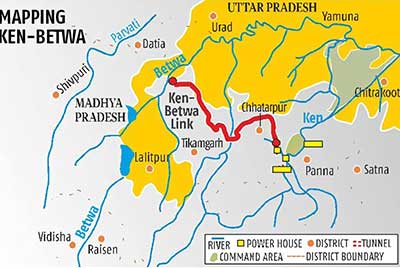GS-3: Different Types of Irrigation and Irrigation Systems; Conservation, Environmental Pollution and Degradation, Environmental Impact Assessment; Major Crops - Cropping Patterns in various parts of the country,
Key phrases - National River Linking Project (NRLP), Multipurpose Project
Why in news-
Cabinet has recently approved ₹ 44,605 Crore Ken-Betwa River Link Project
Analysis:
About Ken-Betwa project
- Ken-Betwa interlinking is a multipurpose water development project.
- Under this project, water from the Ken river will be transferred to the Betwa river. Both these rivers are tributaries of river Yamuna.
- It is one of the smallest components of the proposed National River Linking Project (NRLP) of India.
- The NRLP envisages transferring 178 km3 of water across 37 rivers, through a proposed network of about 30 river links.
- It is an independent link in the peninsular component that connects two small north-flowing rivers namely, the Ken and Betwa rivers in the Greater Ganga Basin.
- In the first phase, a 77-metre high and 2,031-metre-long dam will be constructed at Daudhan village located near the Ken and a 221-km long Ken-Betwa link canal will be built through which water from the Ken will flow into the Betwa basin.
- The project has been delayed for a long time because of disputes between the governments of Madhya Pradesh and Uttar Pradesh over water-sharing.
Benefits of this project
- The project will be of immense benefit to the water-starved region of Bundelkhand.
- Annual irrigation to 10.62 lakh hectares.
- Serve the needs drinking water of 62 lakh people in the region.
- There is a hydropower component to this project as well which will generate 103 MW of electricity.
- 27 MW solar power plant is also proposed.
Concerns about the project
- Inadequate attention has been given to cropping patterns and their suitability to the region. The compatibility of the proposed cropping patterns vis-à-vis the past trends and existing cropping patterns in the KBP area is a major concern.
- Half-baked of the project planning to meet different scenarios of future water resources development needs.
- The feasibility study has inadequate water balance studies
- There was a lack of participation of local people in the decision-making process of project planning.
- Failure to utilize the existing infrastructure to its optimum;
- Lack of alternative options analysis
- Not enough benefits to outweigh the cost
- A total area of around 9,000 hectares will be submerged due to the
proposed dam of which 5,803 hectares lie within the Panna Tiger Reserve,
which is considered to be the core habitat of tigers in the region.
Which are the clearances required for a river-linking project?
4-5 types of clearances are required for the interlinking of river projects. These are:
- Techno-economic (given by the Central Water Commission);
- Forest Clearance and Environmental clearance (Ministry of Environment & Forests);
- Resettlement and Rehabilitation (R&R) Plan of Tribal Population (Ministry of Tribal Affairs) and
- Wildlife clearance (Central Empowered Committee)
Way forward
- It will pave the way for more interlinking of river projects to ensure that scarcity of water does not become an inhibitor for development in the country.
- It is necessary to revisit and address the many concerns that perhaps the feasibility studies may have missed.
- Selecting high-value crops that can increase the net value of crop production benefits at a rate higher than the increase in consumptive water use.
Source: The Hindu























